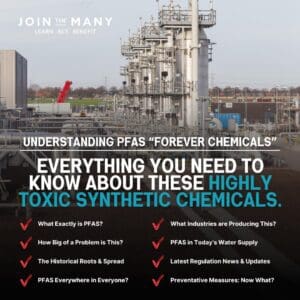Millions of people across various US states were shocked to realize that the water they use at home contains toxic chemicals called PFAS.
These contaminants can cause multiple health issues such as:
- Congenital disabilities and developmental issues
- Cardiovascular issues
- Certain types of cancer
- Reproductive and immunological problems
PFAS are artificial, initially intended for various consumer and industrial products. However, tests discovered that PFAS are present in drinking water, affecting more than 110 million Americans.
What Are PFAS and Why Should You Care?

Per- and polyfluoroalkyl substances, or PFAS, are a class of more than 7,000 artificial compounds famous for their resistance. The two common types of PFAS are Perfluorooctanoic acid (PFOA) and Per-fluorooctane sulfonic acid (PFOS).
Both are resistant to standard environmental degradation and are present in drinking water and the environment, as tests show.
They were common in:
- Some cleaning products
- Stain-resistant fabrics
- Water-resistant clothing
- Firefighting foams
- Non-stick cookware
- Paints and coatings
- Lubricants
- Some personal care and cosmetic products
They have strong chains of fluorine and carbon atoms in their molecular structure. This makes them robust, slippery, and resistant to dissolving or breaking down, hence the nickname ‘Forever Chemicals.’
Over time, PFAS became useful in products we use daily or regularly. Since they don’t break down quickly, they accumulate in the body and remain for extended periods.
If these chemicals enter the environment, they disperse into the soil, water, dust, air, and food. Eventually, they end up in the blood and organs, such as the liver and kidneys.
Overview of Research Findings

Extensive usage of PFAS started in the 1940s, giving scientists adequate time to study the effects of exposure.
Manufacturers like 3M and DuPont also had independent studies in the ’60s and ’70s. They discovered the potential adverse health effects on people and animals.
Since 2005, a scientific panel known as the C8 Science Panel has been responsible for large-scale PFAS research. The panel came to be part of a class action lawsuit against DuPont.
The experts found it challenging to identify the particular PFAS that cause specific health effects.
People get exposed to PFAS in different ways in their lifetime. Exposure can occur in ways such as:
- Eating food from packaging that contains PFAS
- Eating seafood like fish harvested in water contaminated by PFAS
- Swallowing contaminated dust or water
- Drinking contaminated municipal or private well water
This fact makes research more frustrating since the usage of some PFAS evolves, and they end up in more applications.
Despite these challenges, studies show the various possible effects of PFAS exposure on human health. For instance, drinking PFAS-contaminated drinking water links to:
- High cholesterol
- Testicular and kidney cancer
- Thyroid disease
- Ulcerative colitis
- Liver diseases
- Fertility problems
Recent studies also link exposure to PFAS to immune-toxic effects like a potential increase in COVID-19 severity and lower response to vaccines. Even low-level exposure can cause severe health consequences. Several studies show that prenatal PFAS exposure causes low birth weight.
Although US regulations banned PFOS and PFOA production, these chemicals are still in the air, soil, and water. According to the CDC (Center for Disease Control), about 95% of Americans have some form of PFAS in their blood.
Prolonged exposure to PFAS has various side effects such as:
- Higher risk of cancer and asthma
- Increased cholesterol and weight gain
- Disruption of regular hormonal levels
- Adverse impact on immune system function
- Behavior, learning abilities, and growth in children and infants
- Pregnancy-induced or gestational hypertension
PFAS Lawsuit History

As scientists conducted research studies, state regulators implemented bills to address these concerns. This enabled Attorneys Generals and personal injury lawyers to pursue PFA chemical lawsuits.
The federal and state courts receive multiple cases, which fall into two primary categories:
- Remediation actions by government authorities on behalf of their constituents
- Personal injury claims and environmental contamination
In PFAS litigation, related injuries cover:
- Occupational exposure
- Product liability
- Property damage, and
- Personal injury claims.
Pending PFAS-related actions include:
- Class actions over contamination
- Multidistrict litigation
- Corporate lawsuits, including a high-profile case between Chemours and DuPont over PFAS liability
- Military cases
- A class action claiming violations of securities laws against DuPont and 3M
- Multiple state actions against chemical companies
- Utility cases pending in Alabama, California, New York, and New Jersey
The US District Court for the District of South Carolina combined all PFAS cases involving claims and causes of action. The Multi-District Litigation (MDL) 2873 consisted of about five hundred cases.
The plaintiffs claim that AFFFs (aqueous film-forming foams) with PFOS or PFOA contaminated groundwater. The AFFFs were handy in extinguishing liquid fuel fires, but they leaked into the water near industrial sites, airports, and military bases.
The water caused the people to sustain a personal injury that now requires medical attention. They also suffered other economic losses and property damage.
PFAS Litigation Highlights
So far, the PFAS litigation revolved around lawsuits against PFAS manufacturers, mainly 3M and DuPont. The damages and settlements awarded in these cases set a guideline for subsequent issues.
The first PFAS pollution lawsuit against 3M was in Minnesota in 2010. The claim alleged 3M negligently discharged PFAS they used to manufacture Scotchgard in drinking water sources.
The case settled for $850 million in 2018, and the state used these funds to ensure safe drinking water and sustainability in affected areas.
Several other states are close behind, such as Michigan, where the Attorney General went after 17 PFAS manufacturing companies in 2020. The lawsuit claims causes of action under:
- The Michigan Fraudulent Transfer Act
- The Natural Resources and Environmental Protection Act
- Michigan’s laws unjust enrichment, trespass, negligence, and public nuisance
Although this case resolution could take years, it will determine the future of PFAS litigation. This lawsuit includes more diverse defendants than the case in Minnesota.
Jury Verdicts
In 2015, a federal jury in Ohio awarded Carla Bartlett $1.6 million in a lawsuit against DuPont. She claimed to develop kidney cancer after drinking PFAS-contaminated water.
The jury deliberated for only one day to find DuPont liable for $500,000 for emotional distress and $1.1 million for negligence.
In 2016, an Ohio federal jury awarded David Freeman $5 million for his testicular cancer. He alleged that his drinking water had PFOA contamination from a DuPont factory in West Virginia.
After five weeks of trial, the jury took one day to find DuPont liable and awarded Freeman an additional $500,000 since DuPont acted with malice. In 2017, a federal jury in Ohio awarded Kenneth Vigneron $2 million compensatory damages in a suit against DuPont. He claimed to develop testicular cancer due to exposure to PFAS from a DuPont plant.
The jury found that DuPont acted maliciously and awarded Kenneth another $10.5 million in punitive damages.
In 2020, a jury in Ohio awarded Travis Abbot $50 million in a case against DuPont. Abbot drank PFA-contaminated water, causing him to develop testicular cancer. He received compensatory damages worth $40 million, while his wife received $10 million for loss of consortium.
PFAS Litigation Settlements
1999
In 1999, the US District Court for the Southern District of West Virginia received the Tennant litigation.
The case involved a farmer from West Virginia who claimed DuPont contaminated his land. PFOA sludge from a nearby landfill polluted his land, causing his cattle to die.
The settlement in 2002 was $100 Million, and DuPont agreed to fund a scientific panel with $107 million to investigate the impacts of PFOA exposure.
2001
The information discovered in the Tennant case paved the way for another lawsuit in 2001. The case involved 80,000 people residing in districts where PFOA contaminated the water supply.
The suit was settled in 2005 when DuPont agreed to pay $235 million for medical monitoring. These funds were for more than 70,000 people residing in six water districts surrounding DuPont’s Parkersburg plant.
2017
In 2017, the Chemours Company and DuPont agreed to settle $921 million for about 3,500 Ohio Valley lawsuits over illnesses related to C-8. These two companies used the toxic chemical to manufacture Teflon, each paying half the total settlement.
There were more than 1,300 thyroid disease claims, 270 testicular or kidney cancer claims, and about 30 wrongful death claims. Although neither company admitted liability, they paid every plaintiff with cancer about $1.5M and lower amounts for the other claims.
2018
In 2018, the State of Minnesota submitted one of the most famous cases against 3M Corporation. It involved PFAS contamination in ground and surface water where St. Paul and Minneapolis source drinking water.
The state pursued damages worth $5 billion for environmental contamination and the harm caused by drinking the water. The case concluded in 2018, settling for $850 million, which the state used to adopt sustainable water projects and fund drinking water.
2019
In 2019, the West Morgan East Lawrence Water and Sewer Authority filed a lawsuit against Daikin. It involved PFOS and PFOA contaminating the Tennessee River, so the water authority installed a temporary filter.
The filter removed the PFOS and PFOA before the drinking water went out to about 57,000 customers in north Alabama. Daikin agreed on a $4 million settlement to repay the water authority’s funds for the filter.
In 2019, the Michigan Department of Environment, Plainfield Township, Algoma Township, and Great Lakes and Energy filed a suit against Wolverine World Wide.
Wolverine started applying 3M Scotchgard in 1958 and dumped the waste in unlined lagoons and trenches in north Kent County. The PFAS leaked into the groundwater, eventually polluting residential water wells in the area.
A federal judge awarded a $69.5 million settlement for the lawsuit.
2020
In 2020, Wolverine filed a federal lawsuit against 3M for the PFAS contamination. Wolverine alleged that they followed the waste disposal guidelines issued by 3M after using Scotchgard.
Wolverine accused 3M of being aware that chemicals in Scotchgard had significant health and environmental risks. Both companies agreed on a $55 million settlement.
The first home-owner lawsuit involving PFAS-tainted wells involved 3M and Wolverine World Wide. A family in Michigan claimed their drinking water contained toxic PFAS from a nearby manufacturing waste dumpsite decades ago.
Belmont’s Tobyn and Seth McNaughton filed the lawsuit in December 2017, but 3M later became a defendant. The family alleged that the PFAS chemical in their well harmed their property values and health.
Their home is less than a mile south of the House Street dump Wolverine used. Wolverine used 3M Scotchgard at its Rockford tannery to waterproof shoe leather.
Tests of the family’s four-year-old son found exceptionally high PFAS levels of about 484,000 parts per trillion. These high levels affected his immune system and caused issues with vaccination uptake.
The family also blamed the high levels of PFAS in drinking water for:
- Miscarriages
- Pregnancy complications
- High cholesterol
2021
In 2021, Johnson Controls paid $17.5 million to cover individual injury lawsuits and a class action lawsuit. The case involved chemicals in AFFF (aqueous firefighting foam) used by Tyco Fire Products, a subsidiary.
The Wisconsin Tyco Fire Technology Center used AFFF regularly from the 1960s to 2017. The PFAS seeped into the environment, contaminating drinking water in local wells.
The $17.5 Million settlement covers about 300 homes with approximately 1,200 residents in the Marinette/Peshtigo area. $4 million is for PFAS exposure without current disease, and $11 million is for the loss of property value.
The other $2.5 million is for people who developed diseases due to PFAS exposure.
2022
On 25th May 2022, the Commonwealth of Massachusetts filed lawsuits against thirteen companies, including DuPont and 3M.
The lawsuit claimed violations of:
- Massachusetts Consumer Protection Act
- The Safe Drinking Water Act
- Negligence
- Design defect
- Failure to warn
- Trespass
- Public nuisance
Although the main targets were DuPont and 3M, the Commonwealth sued both “New DuPont,” “Old DuPont,” Corteva, and Chemours.
Everyone Deserves Justice

The newly-funded studies and research into PFAS will increase people’s awareness. This will inevitably lead to more lawsuits against chemical suppliers and manufacturers. So far, the size and number of the settlements are encouraging to anyone who suffered injuries after PFAS exposure.
If you or your loved one suffered damages after exposure, you might have a valid PFAS chemicals lawsuit.
Join the Many is here for people in situations like yours. We thrive on the belief that the justice system exists to ensure you get the compensation you deserve.


